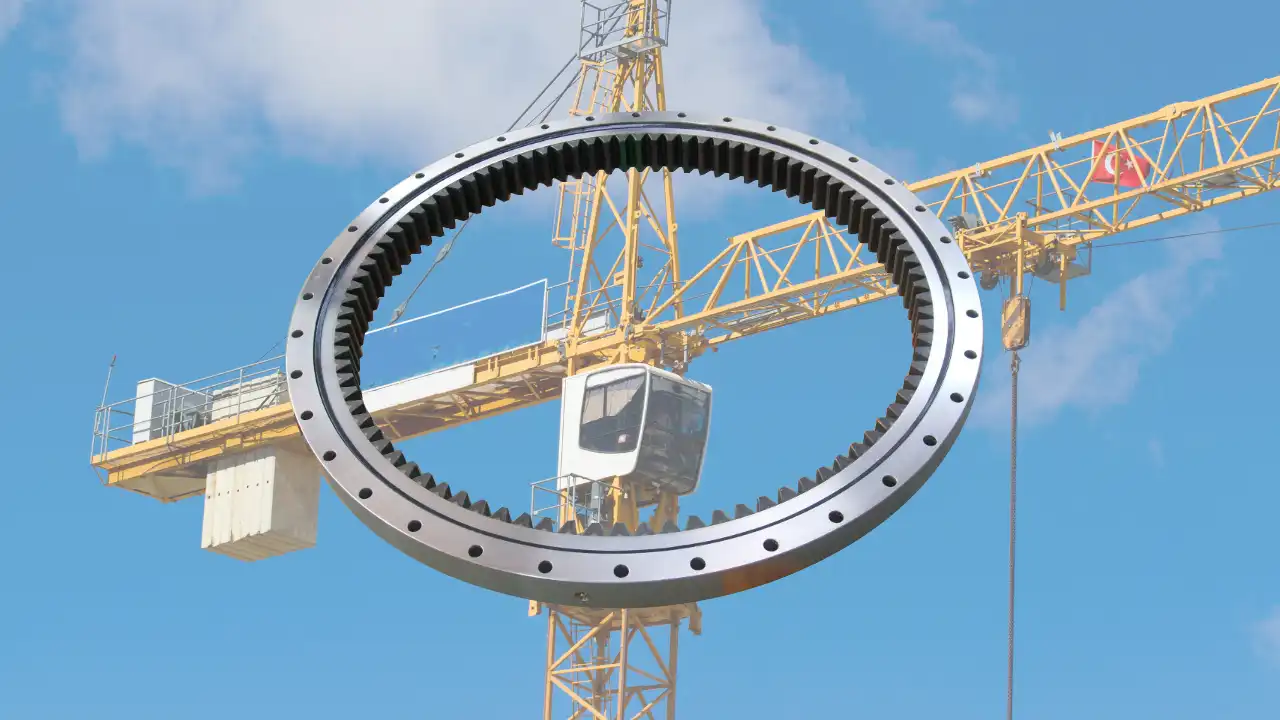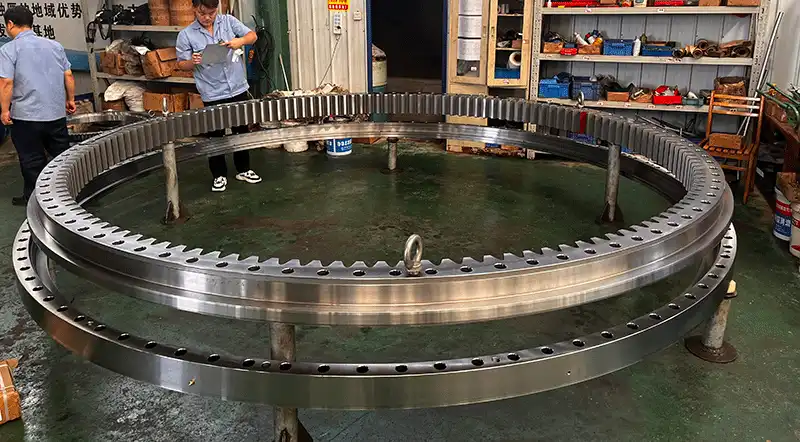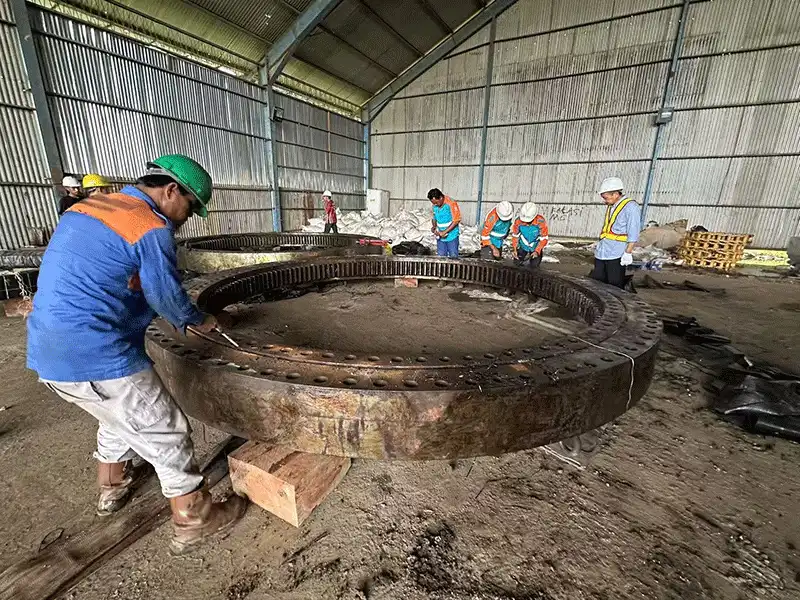Can Tower Crane Slewing Bearings be Repaired or Refurbished?
Tower crane slewing bearings are critical components that play a pivotal role in the functionality and safety of construction equipment. These sophisticated mechanical elements enable the rotating motion of tower cranes, allowing them to move loads with precision and efficiency. However, like all mechanical parts, slewing bearings are subject to wear, damage, and potential performance degradation over time. The question of whether these essential components can be repaired or refurbished is of paramount importance to construction companies, crane operators, and maintenance professionals seeking to optimize equipment longevity and reduce replacement costs.

What Causes Damage to Tower Crane Slewing Bearings and How Can We Detect Early Warning Signs?
Tower crane slewing bearings operate under extreme conditions that expose them to significant mechanical stress and environmental challenges. The continuous rotation, heavy load-bearing requirements, and exposure to harsh construction site environments create a complex set of wear mechanisms that can compromise bearing performance over time.
The primary factors contributing to slewing bearing damage include:
Mechanical stress is perhaps the most significant contributor to bearing deterioration. Tower cranes repeatedly lift and rotate massive loads, subjecting the slewing bearing to tremendous radial, axial, and moment loads. These forces create continuous mechanical strain that gradually impacts the bearing's structural integrity. Precise manufacturing tolerances mean that even microscopic deformations can dramatically reduce bearing efficiency and potentially lead to catastrophic failure.
Environmental conditions play a crucial role in bearing degradation. Construction sites typically expose equipment to dust, moisture, corrosive substances, and temperature variations. Sand, concrete particles, and other abrasive materials can infiltrate bearing seals, causing internal contamination. Extreme temperature fluctuations cause material expansion and contraction, potentially creating microscopic fractures or accelerating wear processes.

Lubrication breakdown represents another critical factor in slewing bearing damage. Inadequate or improper lubrication leads to increased friction, heat generation, and accelerated component wear. Over time, lubricant degradation can cause metal-to-metal contact, resulting in surface scoring, material transfer, and progressive bearing damage.
Early detection of potential bearing issues requires a comprehensive approach involving multiple diagnostic techniques:
1. Vibration analysis provides sophisticated insights into bearing condition by measuring frequency and amplitude of mechanical vibrations. Specialized sensors can detect minute changes that indicate developing wear or damage.
2. Acoustic emission monitoring captures high-frequency sound waves generated by mechanical interactions within the bearing, revealing potential defects before they become visually apparent.
3. Thermal imaging identifies abnormal heat distribution, which often signals increased friction, misalignment, or impending mechanical failure.
4. Regular visual inspections can reveal external signs of wear, such as surface pitting, discoloration, or seal degradation.
Maintenance professionals must develop proactive strategies that combine these diagnostic methods, creating a comprehensive monitoring system that anticipates potential bearing failures before they occur.

Is Professional Repair of Tower Crane Slewing Bearings Economically Viable?
The economic considerations surrounding slewing bearing repair involve a complex evaluation of multiple factors. While complete replacement might seem like the most straightforward solution, professional repair can offer substantial cost savings and operational advantages when approached strategically.
Cost analysis reveals that professional repair typically represents a fraction of the expense associated with total bearing replacement. A comprehensive repair process might cost between 30-50% of a new bearing's price, presenting a compelling financial argument for refurbishment. However, this calculation extends beyond immediate monetary considerations and encompasses broader operational implications.
The repair process for tower crane slewing bearings involves several sophisticated stages:
Initial assessment requires detailed diagnostic procedures to determine the extent of damage and potential repairability. Advanced non-destructive testing techniques like ultrasonic scanning, magnetic particle inspection, and computed tomography provide precise insights into bearing condition.
Dismantling and cleaning represent critical preliminary steps. Specialized cleaning technologies remove contamination, allowing technicians to evaluate individual component conditions. Precision cleaning methods prevent further damage while preparing components for detailed inspection.
Precision machining and component restoration utilize advanced techniques to address surface imperfections. Specialized grinding, honing, and coating processes can restore bearing surfaces to near-original specifications. Cutting-edge technologies like laser cladding and thermal spray coatings enable technicians to rebuild worn surfaces with exceptional accuracy.
Material replacement focuses on strategically addressing specific components showing significant wear. Replacement of critical elements like rollers, raceways, and seals can extend bearing operational life without requiring complete replacement.
Reassembly and testing involve reconstructing the bearing using a combination of restored and new components. Rigorous testing protocols, including load simulation and performance verification, ensure the refurbished bearing meets original manufacturer specifications.
The decision to repair versus replace depends on multiple interconnected variables:
- Bearing age and cumulative operational hours
- Extent and type of observed damage
- Availability of specialized repair resources
- Manufacturer recommendations
- Specific crane operational requirements
How Can Preventive Maintenance Extend Tower Crane Slewing Bearing Lifespan?
Preventive maintenance represents the most effective strategy for maximizing tower crane slewing bearing performance and longevity. A holistic approach combining systematic monitoring, proactive interventions, and strategic maintenance practices can significantly extend operational life while minimizing unexpected downtime.
Comprehensive lubrication management stands as the cornerstone of effective bearing maintenance. Developing a precise lubrication strategy involves:
- Selecting lubricants specifically designed for heavy-duty industrial applications
- Implementing regular lubrication interval assessments
- Utilizing advanced lubricant monitoring technologies
- Establishing contamination control protocols
Environmental protection strategies play an equally crucial role in bearing preservation. Implementing robust sealing systems, developing site-specific protection protocols, and creating controlled maintenance environments can dramatically reduce external wear mechanisms.
Technological innovations are revolutionizing preventive maintenance approaches:
1. Sensor-based condition monitoring systems provide real-time performance data
2. Predictive analytics algorithms help anticipate potential failure modes
3. Machine learning technologies enable more sophisticated diagnostic capabilities
4. Advanced materials science continues to develop more resilient bearing technologies
Training represents another critical aspect of preventive maintenance. Crane operators and maintenance personnel must receive comprehensive education regarding:
- Proper operational techniques
- Early damage recognition
- Basic diagnostic procedures
- Reporting and escalation protocols
Conclusion
Tower crane slewing bearings represent complex mechanical systems that demand sophisticated maintenance approaches. While repair and refurbishment are viable strategies, success depends on timely intervention, specialized expertise, and comprehensive diagnostic capabilities.
Luoyang Huigong Bearing Technology Co., Ltd. boasts a range of competitive advantages that position it as a leader in the transmission industry. Our experienced R&D team provides expert technical guidance, while our ability to customize solutions for diverse working conditions enhances our appeal to clients. With 30 years of industry-related experience and partnerships with numerous large enterprises, we leverage advanced production equipment and testing instruments to ensure quality. Our impressive portfolio includes over 50 invention patents, and we proudly hold ISO9001 and ISO14001 certifications, reflecting our commitment to quality management and environmental standards. Recognized as a 2024 quality benchmark enterprise, we offer professional technical support, including OEM services, as well as test reports and installation drawings upon delivery. Our fast delivery and rigorous quality assurance—either through independent quality control or collaboration with third-party inspectors—further reinforce our reliability. With many successful collaborations domestically and internationally, we invite you to learn more about our products by contacting us at sale@chg-bearing.com or calling our hotline at +86-0379-65793878.
References
1. Smith, J. (2022). "Advanced Bearing Diagnostics in Heavy Machinery" - International Journal of Mechanical Engineering
2. Rodriguez, M. (2021). "Economic Considerations in Industrial Bearing Maintenance" - Engineering Cost Analysis Quarterly
3. Chen, L. (2023). "Predictive Maintenance Technologies in Construction Equipment" - Journal of Mechanical Systems
4. Williams, R. (2022). "Lubrication Strategies for High-Performance Bearings" - Industrial Lubrication Review
5. Garcia, P. (2021). "Non-Destructive Testing in Mechanical Component Evaluation" - Materials Testing International
6. Johnson, K. (2023). "Technological Innovations in Bearing Repair Methodologies" - Advanced Manufacturing Research
7. Lee, S. (2022). "Environmental Factors Affecting Mechanical Bearing Performance" - Mechanical Engineering Insights
8. Patel, R. (2021). "Condition Monitoring Techniques in Heavy Machinery" - Industrial Diagnostics Journal
9. Thompson, D. (2023). "Materials Science Advances in Bearing Technology" - Engineering Materials Quarterly
10. Kumar, A. (2022). "Integrated Maintenance Strategies for Industrial Equipment" - Operational Reliability Review

